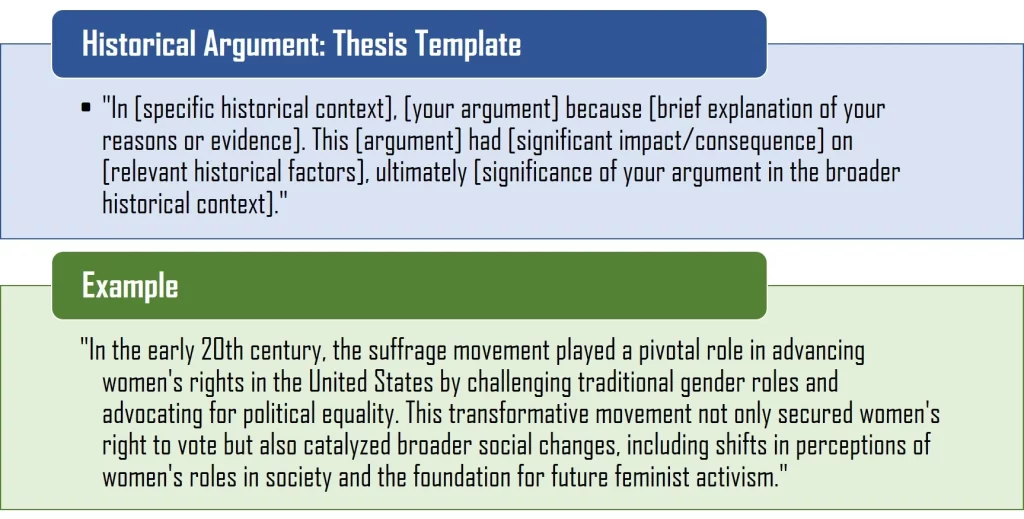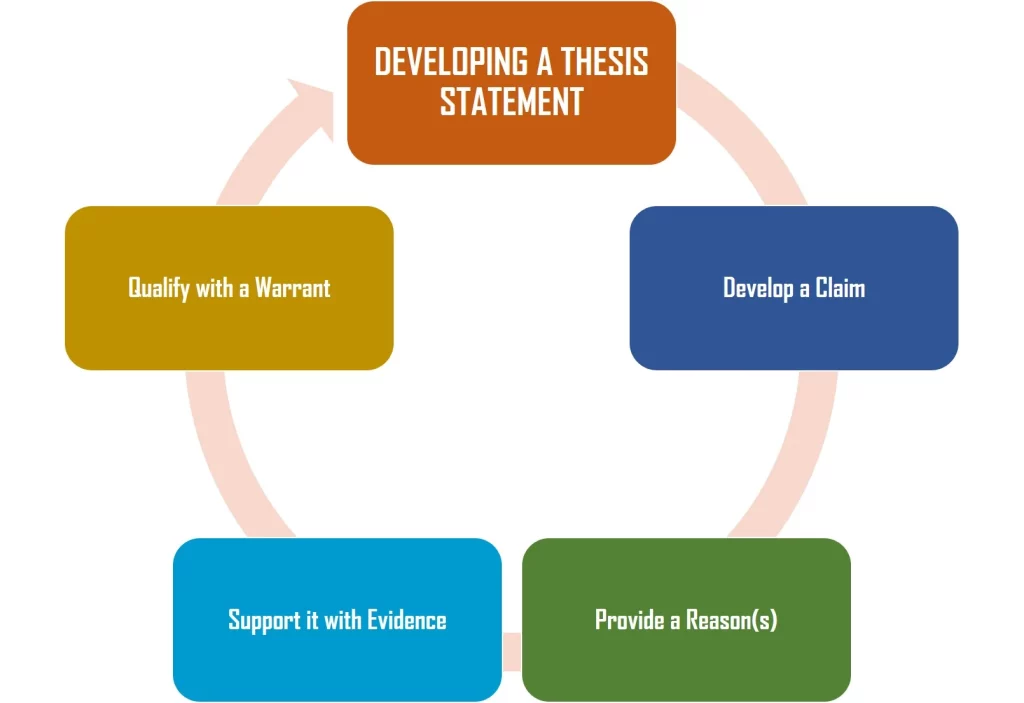- 5-Paragraph Argumentative Essay on Euthanasia
- Aristotelian Argument Essay on Marijuana
- Toulmin Argument Essay on Artificial Intelligence
- Rogerian Argument Essay on Gun Control
- Rebuttal Argument Essay on Renewable Energy
- Sample Historical Argument Essay on the Industrial Revolution
- Literary Argument Essay on 'The Cask of Amontillado'
- Persuasive Argument Essay: Financial Literacy
- Persuasive Argument Essay: Social Media and Politics
- Proposal Argument Essay on Reusable Containers
- Proposal Argument Essay on Workplace Wellness
- Rhetorical Evaluation Argument Essay: MLK's "I Have a Dream"
- Literary Evaluative Argument Essay: "To Kill a Mockingbird"
- Narrative Argument Essay on Resilience
- Definition Argument Essay on Privacy
- Causal Argument Essay on Education

A historical argument is a type of persuasive argument that uses historical evidence and reasoning to support a particular thesis or claim about past events, trends, or interpretations. It seeks to persuade the audience that a specific perspective on a historical topic is accurate, valid, or more compelling than alternative viewpoints. Historical arguments are often used in historical research, essays, and discussions to advance a particular historical interpretation or narrative.
Here is a sample historical argument essay for college students:
Historical Argument Essay on the Industrial Revolution
General Outline
- Introduction:
- Body paragraphs:
- Counterargument and rebuttal:
- Conclusion:
- References or bibliography:
It’s important to note that historical arguments are subject to ongoing scrutiny and revision as new evidence emerges or different interpretations are proposed. Historians engage in a continuous dialogue and debate, refining their arguments based on new findings or alternative perspectives, in an effort to approach a more accurate understanding of the past.
How to Construct Effectively: Steps
- Choose a Historical Topic: Select a specific historical event, period, or topic that you want to analyze and argue about. Define the scope of your argument clearly.
- Research and Gather Evidence:
- Develop a Clear Thesis Statement:
- Analyze and Interpret the Evidence:
- Create a Structured Argument: Organize your argument in a structured manner. A typical historical argument essay includes the following sections:
- Support with Strong Evidence: Use specific examples, quotes, and citations from your historical sources to support your argument. Explain how this evidence relates to your thesis and provides historical context.
- Consider Differing Perspectives: Be aware of and acknowledge differing historical perspectives or interpretations of the same events. Address counterarguments and explain why your perspective is more valid or compelling.
- Engage in Historical Analysis: Analyze the historical context, causes, and consequences of the events you’re discussing. Discuss how historical actors, ideologies, and external factors may have influenced the outcomes.
- Use Clear and Persuasive Language: Write in a clear, concise, and persuasive style. Avoid jargon and present your argument in a way that is accessible to your audience.
- Revise and Edit: Carefully revise your essay for clarity, coherence, grammar, and style. Ensure that your argument flows logically and that your evidence is effectively integrated.
- Finalize Your Essay: Check for proper formatting and citation style, if required by your instructor or publication guidelines.
Writing a historical argument essay involves a comprehensive analysis of historical sources, providing a well-structured argument, and using historical evidence and reasoning to persuasively argue your interpretation of the historical topic or events.
Developing a Historical Argument Thesis Statement

A historical argument thesis statement should clearly state your argument or main point about a historical event, period, or phenomenon. It should be concise, specific, and provide a roadmap for your essay. Here’s a template you can use to craft a historical argument thesis statement:
“In [specific historical context], [your argument] because [brief explanation of your reasons or evidence]. This [argument] had [significant impact/consequence] on [relevant historical factors], ultimately [significance of your argument in the broader historical context].”
Let’s break down this template:
- Begin with the specific historical context: Provide a brief introduction to the time period, event, or situation you are discussing.
- State your argument: Clearly express your main argument or point of view about this historical context. This should be a debatable claim that you intend to prove in your essay.
- Explain your reasons or evidence: In a concise manner, briefly outline the key pieces of evidence or reasoning that support your argument.
- Describe the impact or consequence: Explain what the implications of your argument are in the context of the historical period or event. What changed or was influenced as a result of your argument?
- Highlight significance in the broader historical context: Conclude by discussing why your argument matters in the larger scope of history. How does it contribute to our understanding of the past?
Here’s an example using the template:
“In the years following the American Civil War, the widespread establishment of Jim Crow laws in the American South facilitated the disenfranchisement of Black citizens and created a racially segregated society. This systemic discrimination had a profound impact on African Americans’ socio-economic opportunities, educational access, and political participation, contributing to the persistence of racial inequality in the United States for generations.”
This thesis statement clearly states the historical context, the argument, the evidence (Jim Crow laws), the impact on society, and the broader historical significance. It sets the stage for an essay that will provide evidence and analysis to support this argument.
Historical Arguments Examples
- Topic: The Causes of the American Civil War
Thesis statement: The American Civil War was primarily caused by the conflicting economic, social, and political interests between the North and the South, with slavery as the central underlying issue.
- Topic: The Impact of the Industrial Revolution on Society
Thesis statement: The Industrial Revolution profoundly transformed society by revolutionizing the economy, altering social structures, and sparking technological advancements that continue to shape the modern world.
- Topic: The Influence of Enlightenment Ideas on the French Revolution
Thesis statement: The French Revolution was heavily influenced by the ideas of the Enlightenment, which emphasized individual rights, popular sovereignty, and the need for political and social reforms.
- Topic: The Role of Women in the Suffrage Movement
Thesis statement: Women played a vital role in the suffrage movement, challenging gender norms and advocating for their right to vote, leading to the eventual granting of women’s suffrage in many countries.
- Topic: The Causes and Consequences of World War I
Thesis statement: World War I was primarily caused by a combination of imperial rivalries, militarism, and complex alliance systems, and its consequences reshaped the geopolitical landscape, leading to significant political and social changes.
- Topic: The Impact of the Renaissance on European Art and Culture
Thesis statement: The Renaissance had a profound impact on European art and culture by fostering a renewed interest in humanism, encouraging artistic innovation, and challenging traditional religious and social norms.
- Topic: The Significance of the Treaty of Versailles in Shaping the Post-World War I World
Thesis statement: The Treaty of Versailles played a pivotal role in shaping the post-World War I world by imposing harsh reparations on Germany, redrawing national borders, and setting the stage for future geopolitical tensions and conflicts.
- Topic: The Causes and Consequences of the Great Depression
Thesis statement: The Great Depression was caused by a combination of factors, including the stock market crash, economic inequality, and ineffective government policies, and its consequences had far-reaching effects on global economies, politics, and social welfare.
- Topic: The Role of Nonviolent Resistance in the Civil Rights Movement
Thesis statement: Nonviolent resistance, as championed by leaders such as Martin Luther King Jr. and Mahatma Gandhi, played a pivotal role in the success of the Civil Rights Movement by drawing attention to systemic racism, inspiring mass mobilization, and effecting lasting societal change.
- Topic: The Impact of the Cold War on Global Politics and Ideological Divisions
Thesis statement: The Cold War had a profound impact on global politics and ideological divisions by creating a bipolar world order, intensifying the arms race, and fueling proxy conflicts, shaping the course of international relations for decades to come.
Remember, the key to writing a successful historical argument is to thoroughly research and analyze historical evidence, use sound reasoning, and construct a clear and well-structured narrative that supports your thesis or claim about a historical topic. Your argument should be grounded in historical context and supported by credible sources and evidence.
